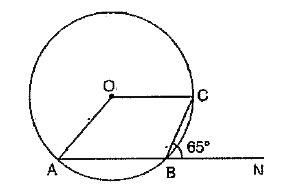Two straight lines AB and AC include an angle. A circle is drawn in this angle which touches both these lines. One more circle is drawn which touches both these lines as well as the previous circle. If the area of the bigger circle is 9 times the area of the smaller circle, then what must be the angle A ?
45∘
60∘
75∘
90∘
To solve the problem step by step, we will follow the reasoning provided in the video transcript.
1. Define the Radii of the Circles:
Let the radius of the smaller circle be r1=A and the radius of the larger circle be r2=B. According to the problem, the area of the larger circle is 9 times the area of the smaller circle.
Hint: Remember that the area of a circle is given by the formula Area=πr2.
2. Set Up the Area Ratio:
Given that the area of the larger circle is 9 times that of the smaller circle, we can express this as:
πB2=9πA2
Dividing both sides by π gives:
B2=9A2
Taking the square root of both sides, we find:
B=3A
Hint: When dealing with ratios of areas, remember that the ratio of the radii is the square root of the ratio of the areas.
3. Consider the Triangle Formed by the Circles:
In the triangle formed by the points where the circles touch the lines, we can denote the angle at point A as ∠BAC. The smaller circle touches both lines and the larger circle also touches both lines and the smaller circle.
4. Using Triangle Properties:
In triangle AOQ (where O is the center of the smaller circle), we can use the sine function:
sin(∠QAO)=OQAO=AAO
Thus, we can express AO as:
AO=Asin(∠QAO)
Hint: Recall that the sine of an angle in a right triangle is the ratio of the opposite side to the hypotenuse.
5. For the Larger Circle:
Similarly, for triangle APR (where P is the center of the larger circle), we have:
sin(∠PAR)=PRAP=BAP
So, we can express AP as:
AP=Bsin(∠QAO)
Hint: Make sure to keep track of which triangle you are working with and the corresponding sides.
6. Set Up the Equation:
The distance between the centers of the circles can be expressed as:
AP−AO=B−A=B−Asin(∠QAO)=B+A
Substituting B=3A:
(3A−A)sin(∠QAO)=3A+A
This simplifies to:
2Asin(∠QAO)=4A
Dividing both sides by A (assuming A≠0):
2sin(∠QAO)=4
Therefore:
sin(∠QAO)=12
Hint: When solving for sine values, remember the common angles and their sine values.
7. Find the Angle:
The angle ∠QAO for which sin(∠QAO)=12 is:
∠QAO=30∘
Hint: Use the unit circle or a sine table to find the angle corresponding to a sine value.
8. Calculate Angle A:
Since ∠BAC=2×∠QAO:
∠BAC=2×30∘=60∘
Hint: When dealing with angles formed by lines and circles, remember to consider the relationships between the angles.
Final Answer:
The angle A must be 60∘.
Let the radius of the smaller circle be r1=A and the radius of the larger circle be r2=B. According to the problem, the area of the larger circle is 9 times the area of the smaller circle.
Given that the area of the larger circle is 9 times that of the smaller circle, we can express this as:
πB2=9πA2
Dividing both sides by π gives:
B2=9A2
Taking the square root of both sides, we find:
B=3A
In the triangle formed by the points where the circles touch the lines, we can denote the angle at point A as ∠BAC. The smaller circle touches both lines and the larger circle also touches both lines and the smaller circle.
In triangle AOQ (where O is the center of the smaller circle), we can use the sine function:
sin(∠QAO)=OQAO=AAO
Thus, we can express AO as:
AO=Asin(∠QAO)
Similarly, for triangle APR (where P is the center of the larger circle), we have:
sin(∠PAR)=PRAP=BAP
So, we can express AP as:
AP=Bsin(∠QAO)
The distance between the centers of the circles can be expressed as:
AP−AO=B−A=B−Asin(∠QAO)=B+A
Substituting B=3A:
(3A−A)sin(∠QAO)=3A+A
This simplifies to:
2Asin(∠QAO)=4A
Dividing both sides by A (assuming A≠0):
2sin(∠QAO)=4
Therefore:
sin(∠QAO)=12
The angle ∠QAO for which sin(∠QAO)=12 is:
∠QAO=30∘
Since ∠BAC=2×∠QAO:
∠BAC=2×30∘=60∘
The angle A must be 60∘.
Similar Questions
Knowledge Check
The equations of the circles which touch both the axes and the line x = a are
Ax2+y2±ax±ay+a24=0Bx2+y2+ax±ay+a24=0Cx2+y2−ax±ay+a24=0Dnone of theseThe equations of the circles which touch both the axes and the line x = a are
Ax2+y2±cx±cy+c24=0Bx2+y2+cx±cy+c24=0Cx2+y2−cx±cy+c24=0Dnone of theseWhat is the equation of circle which touches the lines x = 0 ?
Ax2+y2+2x+2y+1=0Bx2+y2−4x−4y+1=0Cx2+y2−2x−2y+1=0DNone of these
If the area of a sector of a circle is 1/6 of area of the circle, then the angle of the sector is ________.
View SolutionFind the locus of centres of circles which touch two intersecting lines.
View SolutionEquation of circles which touch both the axes and also the line x=k(k>0) is
View SolutionA circle of diameter 8 cm is placed in such a manner that it touches two perpendicular lines. Then another smallerr circle is placed in the gap such that it touches the lines and the circle. What is the diameter of the smaller circle?
View SolutionO is the centre of the circle, ABN is a straight line. Find ∠AOC.

View Solution
